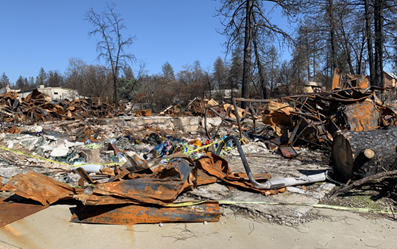The Town of Paradise employed innovative tactics with state and federal support to empower low-to-moderate income residents to rebuild their homes safely and navigate disaster assistance options after the Camp Fire. Establishing a Building Resiliency Center provided a single place to assist property owners with their rebuilding needs and questions. Direct engagement with impacted residents and a focus on customer service helped overcome challenges and provides an example of trauma-informed disaster assistance at the local level.
Background
Everything had changed. Every property within the Town of Paradise was impacted by the fire. Burnt trees and piles of rubble now stood where a green envelope had once drawn the community together. Paradise had been in the direct line of fire of the Camp Fire, at the time the deadliest and most destructive wildfire in California’s history.
“…Our town was forever changed by the Camp Fire. Now it is time to begin rebuilding for our families and neighbors.” – Jody Jones, Mayor, Town of Paradise

The Town of Paradise is a rural mountain community in Butte County, California with a 2018 population of around 26,600 residents, many of whom were lower income retirees or commuters that had been attracted to the area by affordable housing stock in the wildland-urban interface. What started as an electrical spark at 6:30 a.m. on November 8, 2018, destroyed over 90% of Paradise within six hours. The fire took 85 residents’ lives and damaged or destroyed over 19,000 homes, businesses, and community structures. The Camp Fire displaced roughly 50,000 people and left the vast majority of the population of the rural mountain community without a home or place of employment.
California Governor Jerry Brown declared a State of Emergency in Butte County on November 8, with President Donald Trump issuing a Major Disaster Declaration for California just days later. California deployed its six state-led Recovery Support Functions (RSFs) comprised of state agencies that mirror the federal RSFs in the National Disaster Recovery Framework (NDRF) in their approach to supporting local government’s disaster recovery goals. The California Governor’s Office of Emergency Services (CalOES) deployed its Interagency Recovery Coordination (IRC) team to manage the RSFs shortly after the incident and begin supporting the affected local jurisdictions. FEMA also deployed an IRC team in late November to evaluate federal support needed. FEMA activated all six federal RSFs by January 2019, including the Community Assistance (formerly CPCB) and Housing RSFs to assist Paradise in its planning and housing recovery missions.
Activated Federal Recovery Support Functions (RSFs)
- Community Assistance – led by FEMA
- Housing – led by the United States (U.S.) Department of Housing and Urban Development (HUD)
- Economic Recovery – led by the U.S. Economic Development Administration (EDA)
- Infrastructure Systems – led by the U.S. Army Corps of Engineers (USACE)
- Natural and Cultural Resources (NCR) – led by the U.S. Department of the Interior (DOI)
- Health and Social Services (HSS) – led by the U.S. Department of Health and Human Services (HHS)
View Case Study
View Teaching Notes

